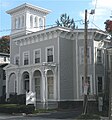Orange Street Historic District
Orange Street Historic District | |
 436 and 444 Orange St. | |
| Location | Roughly bounded by Whitney Ave., State, Eagle & Trumbull Sts., New Haven, Connecticut |
|---|---|
| Coordinates | 41°18′56″N 72°54′55″W / 41.31556°N 72.91528°W |
| Area | 125 acres (51 ha) |
| Built | 1830 |
| Architect | Multiple |
| Architectural style | Greek Revival, Italianate, Queen Anne |
| NRHP reference No. | 85002314[1] |
| Added to NRHP | September 12, 1985 |
The Orange Street Historic District encompasses a large residential in the
New Haven's early economy was based mainly on trade based around its port. In the 1820s, the Farmington Canal opened, spurring a round of industrial development that was accompanied by population growth. The Orange Street area, located northeast of the New Haven Green, was one of the areas that saw significant development during this period. Around 1850, the city became a railroad transportation hub, and its industrial base expanded significantly. Residential growth in the Orange Street area expanded beyond Clark Street, into an area that was until 1850 farmland.[2]
The district is an irregularly shaped area bounded on the northwest by Orange Street, between Audubon and Cottage Streets. The northwestern half of Orange Street is included in the Whitney Avenue Historic District, which abuts the Orange Street Historic District on the west. The southeastern boundary is State Street, although no buildings facing State Street are included. Most of the buildings in the district are residential, and are of wood-frame construction. They are stylistically diverse, with representative examples of styles from the late Federal period of the 1820s to the Colonial Revival of the early 20th century.[2]
Gallery
-
Everard Benjamin House (1838), 232 Bradley St., with Ionic portico.
-
10 Lincoln St. (about 1840).
-
Gothic cottage, 12 Lincoln St. (about 1840).
-
Timothy Lester House (1846), 431 Orange St., toweredItalian villa.
-
223 Bradley St. (about 1848), home of George Dudley Seymour.
-
Greek Revival porch, 445 Orange St. (about 1855).
-
Nehemiah Sperry House (1857), 466 Orange St.
-
Italian villa, 400 Orange St. (about 1857).
-
John C. Anderson House (1882), 444 Orange St.
-
Temple Mishkan Israel (1897), 55 Audubon St.
See also
References
- ^ a b "National Register Information System". National Register of Historic Places. National Park Service. March 13, 2009.
- ^ a b c Dorothea Penar; J. Paul Loether & John Herzan (February 27, 1985). "National Register of Historic Places Inventory-Nomination: Orange Street Historic District". National Park Service. and Accompanying 34 photos, from 1984 and 1985












